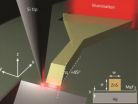(Press-News.org) Frequently cited studies involving associations of biomarkers report effect sizes that are often larger when compared to summary estimates from meta-analyses evaluating the same associations, according to a study in the June 1 issue of JAMA.
"Many new biomarkers are continuously proposed as potential determinants of disease risk, prognosis, or response to treatment. The plethora of statistically significant associations increases expectations for improvements in risk appraisal. However, many markers get evaluated only in 1 or a few studies. Among those evaluated more extensively, few reach clinical practice. This translational attrition requires better study. Are the effect sizes proposed in the literature accurate or overestimated?" the authors write.
John P. A. Ioannidis, M.D., D.Sc., of the Stanford University School of Medicine, Stanford, Calif., and University of Ioannina School of Medicine, Ioannina, Greece, and Orestis A. Panagiotou, M.D., of the University of Ioannina School of Medicine, conducted a review of the medical literature to examine biomarkers that had been evaluated in at least 1 highly cited study and for which at least 1 meta-analysis had been performed for that same association to compare the effect size of these associations. Eligible articles were those that had received more than 400 citations in the ISI Web of Science and that had been published in any of 24 highly cited biomedical journals. MEDLINE was searched for subsequent meta-analyses on the same associations (same biomarker and same outcome). The researchers identified 35 highly cited studies published between 1991 and 2006 for inclusion in the study. The highly cited biomarkers included genetic risk factors, blood proteins, other blood biomarkers, and infectious agent biomarkers. Cancer-related and cardiovascular-related outcomes predominated.
The researchers found that for 30 of the 35 associations (86 percent), the highly cited studies had a stronger effect estimate than the largest study; for 3 the largest and highly cited study coincided; and only twice was the effect estimate stronger in the largest than in the highly cited study. The relative risk estimate was in the opposite direction in the highly cited than in the largest study in 5 associations, and the increase was more than 2-fold greater in another 20 associations (more than 4-fold in 13 associations).
For 29 of the 35 highly cited studies (83 percent), the corresponding meta-analysis found a smaller effect. The relative risk estimate was in the opposite direction in the highly cited than in the meta-analysis in 4 associations and the increase was more than 2-fold greater in another 14 associations (more than 4-fold in 7 associations), the authors write. Only 15 associations were nominally statistically significant based on the largest studies. Thirty-two of the 35 associations showed nominally statistically significant increased risk based on the meta-analyses.
The researchers write that several reasons could explain false-positive and inflated results among the examined highly cited investigations. "Many of these studies were relatively small and among the first to report on the association of interest. Discoveries made in small studies are prone to overestimate or underestimate the actual association. Interest in publishing major discoveries leads to selective reporting from chasing significance."
"… our study documents that results in highly cited biomarker studies often significantly overestimate the findings seen from meta-analyses. Evidence from multiple studies, in particular large investigations, is necessary to appreciate the discriminating ability of these emerging risk factors. Rapid clinical adoption in the absence of such evidence may lead to wasted resources."
(JAMA. 2011;305[21]2200-2210. Available pre-embargo to the media at www.jamamedia.org)
Editor's Note: Please see the article for additional information, including other authors, author contributions and affiliations, financial disclosures, funding and support, etc.
Editorial: The Thin Line Between Hope and Hype in Biomarker Research
In an accompanying editorial, Patrick M. M. Bossuyt, Ph.D., of the University of Amsterdam, the Netherlands, writes that it would be premature to doubt all scientific efforts at marker discovery and unwise to discount all future biomarker evaluation studies.
"However, the analysis presented by Ioannidis and Panagiotou should convince clinicians and researchers to be careful to match personal hope with professional skepticism, to apply critical appraisal of study design and close scrutiny of findings where indicated, and to be aware of the findings of well-conducted systematic reviews and meta-analyses when evaluating the evidence on biomarkers."
(JAMA. 2011;305[21]2229-2230. Available pre-embargo to the media at www.jamamedia.org)
Editor's Note: Please see the article for additional information, financial disclosures, funding and support, etc.
###
To contact John P. A. Ioannidis, M.D., D.Sc., call Krista Conger at 650-725-5371 or email kristac@stanford.edu. To contact editorial author Patrick M. M. Bossuyt, Ph.D., email p.m.bossuyt@amc.uva.nl.
END
Despite concerns that surgeon fatigue is leading to dangerous complications for patients and data showing worse outcomes for many patients who undergo surgery at night, new Johns Hopkins research suggests that — in the case of heart and lung transplants — time of day has no affect on patient survival.
"We aren't suggesting that fatigue is good," says Ashish S. Shah, an assistant professor of surgery at the Johns Hopkins University School of Medicine and the study's lead author. "But what is important is that, at least in this specialty, it seems we're able to deal with ...
A cloud-based environment offers convenient and cost-effective access to technology. However, it also increases the security risk and need for appropriate authentication and authorization processes--particularly as enterprise information extends from in-house systems to popular software-as-a-Service (SaaS) offerings, such Salesforce.com and Google Apps. A cloud-based approach to centralized identity management provides a robust alternative to server-based solutions for enabling secure access to diverse applications, whether on-premise or running as SaaS.
IT architects ...
New research from the University of Leicester raises concerns about higher than expected mortality following acute coronary events such as heart attack in those with significant mental ill health.
Researchers from the University of Leicester in the UK and Curtin Health Innovation Research Institute in Australia examined 22 previous studies involving 825,754 individuals, comparing care given to those with and without serious mental disorders.
They discovered that there was higher than expected mortality following acute coronary events such as heart attack in those ...
Since the Industrial Revolution, over half of all the CO2 produced by burning fossil fuels has been absorbed by the ocean, making pH drop faster than any time in the last 650,000 years and resulting in ocean acidification. Recent studies have shown that this causes fish to lose their sense of smell, but a new study published today in Biology Letters shows that fish hearing is also compromised.
Working with Professor Philip Munday at James Cook University, lead author Dr Steve Simpson of the School of Biological Sciences at the University of Bristol reared larvae straight ...
Irvine, Calif. — Environmental and inherited risk factors associated with multiple sclerosis – previously poorly understood and not known to be connected – converge to alter a critical cellular function linked to the chronic neurologic disease, researchers with the UC Irvine Multiple Sclerosis Research Center have discovered.
The findings, which appear in the online, open-access journal Nature Communications, suggest that a unifying mechanism may be responsible for multiple sclerosis and point to therapies personalized according to genetic factors.
"MS results from ...
Long-term relationships make the commonly abused drug amphetamine less appealing, according to a new animal study in the June 1 issue of The Journal of Neuroscience. The findings suggest that social bonds formed during adulthood lead to changes in the brain that may protect
against drug abuse.
Prairie voles are rodents that form lifelong bonds with mating partners. In the new study, researchers directed by Zuoxin Wang, PhD, of Florida State
University, found that male voles in established relationships displayed less interest ...
STANFORD, Calif. — More than two dozen widely cited studies linking genes or other "biomarkers" to specific diseases vastly overstate the association, according to new research from an expert in scientific study design at the Stanford University School of Medicine. As a result, clinicians may be making decisions for their patients based on inaccurate conclusions not supported by other, larger studies.
The widely cited studies include one linking the BRCA1 mutation with colon cancer, another that links levels of C-reactive protein in the blood with cardiovascular disease ...
The creation of a new quasiparticle called the "hybrid plasmon polariton" may throw open the doors to integrated photonic circuits and optical computing for the 21st century. Researchers with the U.S. Department of Energy (DOE)'s Lawrence Berkeley National Laboratory (Berkeley Lab) have demonstrated the first true nanoscale waveguides for next generation on-chip optical communication systems.
"We have directly demonstrated the nanoscale waveguiding of light at visible and near infrared frequencies in a metal-insulator-semiconductor device featuring low loss and broadband ...
Two years ago, a widely publicized scientific report plucked an old mouse virus out of obscurity and held it up as a possible cause of Chronic Fatigue Syndrome. According to a new study published today by a group of researchers in California, Wisconsin and Illinois, that report was wrong.
The mouse virus is not the culprit in Chronic Fatigue Syndrome, said University of California, San Francisco Professor Jay A. Levy, MD, the senior author on the study, published this week by the journal Science.
"There is no evidence of this mouse virus in human blood," said Levy, ...
A cell phone-sized, wireless near-infrared device is as reliable as the current "gold standard" invasive tests in determining bladder disease, according to a study by researchers at the University of British Columbia, Vancouver Coastal Health and the Child & Family Research Institute (CFRI).
The new physiologic information gathered through near-infrared spectroscopy (NIRS) could also advance treatment that tackles the root causes of urinary incontinence, says the research team.
Published in the current issue of the International Journal of Spectroscopy, the study is ...


